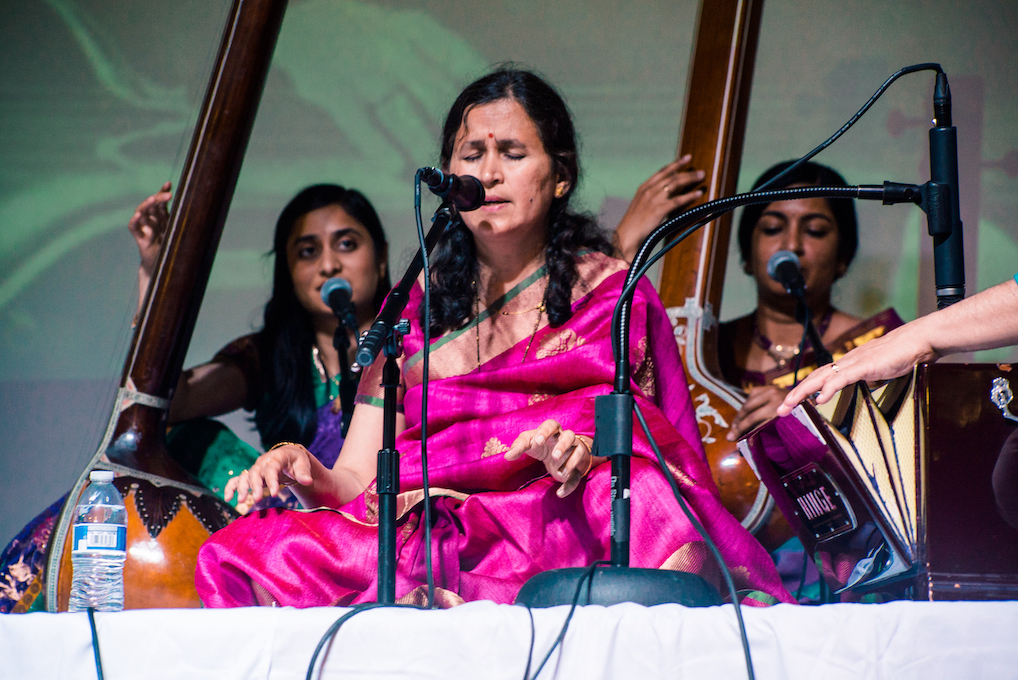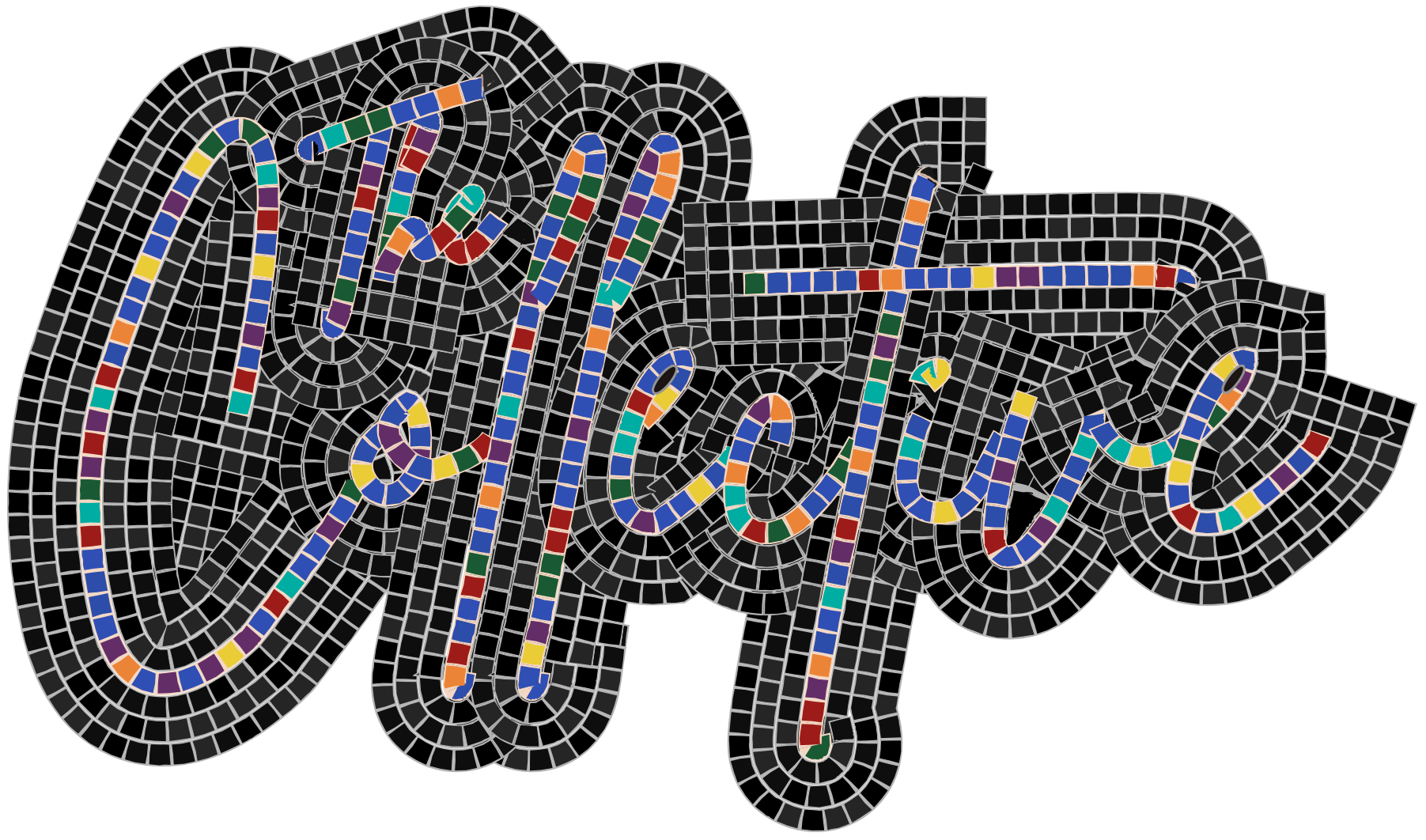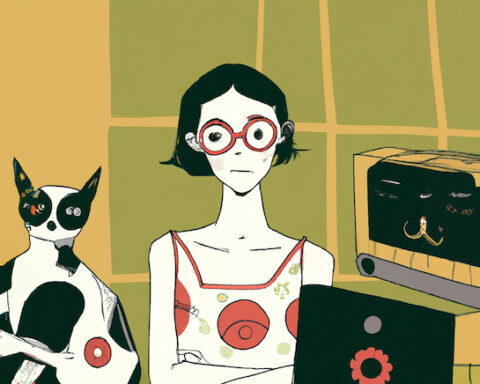Editors Dani and Elisa spoke to Shubhangi Sakhalkar about her career and life as a Hindustani vocalist, artist, and feminist. This interview took place on May 19, 2022 over a Zoom video call.
Shubhangi Sakhalkar, a Hindustani classical vocalist, has been teaching and performing for over thirty years. After beginning her musical training with Smt. Kunda Vaishampayan, she went on to learn for several years from the renowned stalwarts Dr. Prabha Atre and Smt. Padma Talwalkar. From her teachers, Shubhangi inherited the best characteristics of three different gharanas: the Gwalior gharana’s clarity of raga presentation; the Kirana gharana’s purity of sur and vocal production; and the Jaipur gharana’s attention to intricate detail of pattern and rhythm. Shubhangi’s artistic development has also been enhanced by academic training. She earned a gold medal for completing a master’s degree in music at the top of her cohort. In addition, Shubhangi has brought her own dedicated riyaaz, creative imagination, and keen intellect to bear upon her art. She has developed a dynamic yet thoughtful vocal style that remains rooted in tradition while being uniquely her own. Shubhangi has performed widely all over India and the US. She is widely recognized as one of the finest exponents of Hindustani classical music in the United States. In order to nurture and promote Hindustani classical music in North America, Shubhangi has set up the Intonation Foundation, which organizes the annual Ustad Amir Khan Music Festival to showcase the talents of artists based in the U.S. and Canada.
Elisa. What are the differences between classical Hindustani music and Western classical music? We can begin with music theory and pedagogy.
Shubhangi. I’m not sure if I ever told you, but I have a master’s degree in music. And there we had to learn a little bit of Western classical music, too — just the theory part — so we were always comparing the differences and similarities between the two. You might have heard of this concept of raag; Hindustani classical music is based on them. Raags are a set of notes that make a beautiful tune, which create some unique mood or atmosphere. There are about 300 raags, and most of them were created in the 1600s. They are ancient.1 Universally, the number of notes in any kind of music is the same twelve notes in a scale. Some of these notes, when you put them in a specific combination, or a specific pattern, create these melodies called raags.
Let’s talk about just one raag, because if you don’t understand this concept, then you will not understand the rest. In the basic scale, you can change the second note or the fourth note, or sometimes you just take five notes. And sometimes going up you take five notes and coming down you might take six or seven; so there are hundreds of different combinations you can do. But only some of those will make good and meaningful songs, like a painting or a picture. The thing is that you cannot change the scale like in Western classical music; I’ve heard that you can transition from one key to another, but here you can’t do that. The first note is very, very important in raags. All of your thoughts start from there and end there. In music theory, each raag has two main important notes: the first note is called Vadi swara, the most important note of the raag. And there is another one that is the supporting note: Samvadi swara. The whole raag revolves around these two notes. They are like the two main characters in a movie.
I’m going to demonstrate a little bit. For example, the five-note pentatonic scale is a very big raag in Hindustani music, sa re ga pa dha sa. All of the phrases, they will start with the first note — that concept is unique in Hindustani music.
Shubhangi sings the pentatonic scale
Shubhangi demonstrates some beautiful phrases of this raag, always starting with the bass note “sa.”
The second difference is, it is totally melody based; there is no concept of harmony or two different tunes put together. There are not even different instruments coming together and playing different tunes with a harmony part — that is the main thing in Western classical music — we never use that. In Hindustani music, it’s a solo of one singer or one instrument, just that solo instrument playing.
Elisa. Does that mean if there’s percussion also playing with a vocalist, for instance, that it would be improvising along with the singer? How does that work?
Shubhangi. The percussion instrument can also be a solo instrument. There are concerts with just a tabla [percussion] or a sarangi, which is like a Western violin, played as one tune. But percussion mostly performs pre-composed pieces, whereas the instrumental or vocal is mostly improvised within the raag. Once you know how the raag goes, what notes are played and in what way (with everything starting from the first note), it is your choice – to put those notes the way you like it.
That’s why the training is mostly oral, or in a very traditional way. First, you write down very few things, like the basics of what notes are in the raag. And then whatever your teacher sings or plays, you follow it. That’s how you learn. When I teach, I give four notes, for example, and ask what the student can come up with — something that is creative and has good meaning. Not something random. These kinds of exercises are what you take home and memorize and practice. Of course, I give them some set patterns for voice training, which is a different thing. In that, you practice set patterns to learn the technique, but the actual music you only learn with your teacher through repetition. Because feeling and laya (tempo) you can only really understand at that moment. Tempo is very important in any music field: if you can feel it, only then can you play it.
Dani. When you work with students on those five notes, and they’re coming up with things to play, how do you guide them to understand what is random versus what has meaning?
Shubhangi. There are some basic structured phrases that we practice. Training is mainly your ear needing to get trained; you should be a very good listener in order to be a good musician. And then logic — I give different examples and ask which one is better. For example, in the raag Bhoop, there are just four notes like these [demonstrates]. This is a good, nice elaborative phrase, but if you just put Dha Re Ga, that is not very musical; it doesn’t follow the rules of the raag.
Shubhangi sings examples of the raag Bhoop.
That’s why your teacher has to be present to correct you when you do something. Usually everybody agrees when something doesn’t sound right or is not that good. This is a very simple raag that I’m giving as an example, but there are so many other raags which have very tight structure — you can use the notes only in a very particular way while going up, and coming down it’s a different way. Then it becomes very tricky to improvise; you have to know the structure very well.
Elisa. Can you tell us more about the vocal technique?
Shubhangi. Compared to the Western style of singing, you have different voices for different ranges (head voice and chest voice). In Hindustani music, we have only chest voice. For the higher notes, it’s not completely head; it’s a blend of chest and head voice. Patterns that go from the lowest note to the highest all are done in one voice without changing. That’s how you train your voice.
In vocal concerts, we mostly use three instruments. One is the droning instrument, the tanpura, which only plays two notes, the first and then the fifth note. This creates the atmosphere and gives the pitch. And then there is an accompanying instrument, which is usually sarangi. It’s my most favorite instrument. The tone is almost like a human female voice. And it touches your heart, that tone. People use harmonium, which is like a piano, but currently players for this are very rare. The raag is also usually performed in a rhythm setting. In the song, the words are not very important; the musical content is most important. But the song plays in one rhythm cycle, and the raag is developed using that rhythm cycle and the words of the song. This makes the tabla very, very important. You have to have very good relationships with your colleagues. If the regular musicians are not there, and I have to use someone else, it’s very difficult for me, because you understand each other so well. You know if I do this, then he’s going to do this, she’s going to do that. It is a real team effort.

Dani. Doesn’t the rhythmic cycle also have a name?
Shubhangi. Yes, taal. There are different kinds of rhythms that are used: 16 beat cycle, 12, 7, 10, 6, 14.
Dani. And are the three instruments and voice performed in different combinations, or does it stay the same with all performers all the time?
Shubhangi. No, you have to have all of them. If there is just an instrumental concert, for example, sitar, then you don’t need the accompanying instrument. Then it’s just sitar and tabla. But for voice you need both the tabla and accompanying instrument.
Dani. In Western classical music we talk a lot about tone colors and changing timbre. Do you have vocal techniques or ways of doing or talking about that concept?
Shubhangi. Unfortunately, our own voice training is not as developed as in Western music. But I’ve tried to bring that out in my music because I listened to a lot of Western music, as well, and I’ve tried to learn how they use their voices in different ways. If you’re a vocalist, the instrument is in your body. I shouldn’t say it’s more difficult than learning an instrument, but in India, they don’t give so much importance to how you can use your voice in different ways or how you can sound better. It’s the musical content that is considered very, very important. I’ve tried to change that a lot. Even when I teach, I teach according to each of my students. They have different voice qualities, so I tell them, You try this; it will sound better in your voice — something like that. When I did my master’s, I was always interested in learning about world music, in general. Our professor used to play different kinds of music, which was very new to me. And I was fascinated by how music is so rich in different cultures.
Elisa. I feel that we’re barely grazing the surface. I could talk to you for hours!
Shubhangi. We can do part two sometime. [Laughs]
Elisa. You’ve talked a little bit about the philosophy and value differences between Western and Hindustani music. Did you want to expand on that?
Shubhangi. Spirituality is the main thing in Hindustani music. And the purpose of your whole practicing and studying music is finding yourself, ultimately — not just what you like — but for me, it’s how you can apply that in your life. Your relationship with music — oh, it’s so pure. Because music doesn’t lie or cheat or anything. It’s just so honest and true. So, you can be more like it in your real life and give more joy and create more joy.
Dani. That’s really beautiful.
Shubhangi. Faith and devotion are the two main values, which are very, very important in our culture, musically. And generally in Indian culture, they’re very important, but in music, finding a good teacher is your feat. I was fortunate to have good gurus in my life, and whatever they told me I followed, and it really made me who I am today. If you constantly question everything, then you don’t have a place to have faith. I believe strongly in having faith. Of course, if the guru is not good, or you don’t have that trust, then I don’t mean to say that you should still follow. But the guru is kind of like one of your parents.
Elisa. That’s very different from Western music. I mean, there’s certainly a special relationship between teacher and student. And there’s even maybe a parental feeling, but it sounds like in India it’s more spiritual and devotional.
Shubhangi. Yeah, yeah. A lot of it’s not a very good thing, I would say, in Indian culture, because people blindly follow the gurus. Many teachers, unfortunately, take advantage of this and are also abusive. So you have to watch out for that.
Dani. I was going to say that the teacher-student relationship is often very precious, and because of its intimate nature, it’s very easy to cross into the territory where abuse can happen. And for students and teachers both, it’s sometimes hard, at first, to tell when or how this happens. So, then, you said that if your guru is not good, then you shouldn’t follow or trust them. How do students learn to tell who to trust, and who to not? Is it just basic discernment, or does something specific signal a problem?
Shubhangi. If they didn’t know, then in a couple of years, they will know. But you have to give those two years. You can’t make any judgment right away. Whenever I went to my guru, I asked some people, how do you know about this person? Is she good? I had three teachers. The first one was when I was in college, and she was a very, very good person. There was no question about that. The second one, she was my professor when I did my masters. The third one was later; I had most of my training from her. I had heard that she’s very strict. I met with her, and I understood she was very passionate and was very, very important. Her core standards were very high. I knew that it was going to be tough learning from her, but I decided to try it out. She told me to practice early morning, at 5am. I actually did it for three years. Because in India, we have this concept of, if you practice early morning and you practice the lower notes, then it’s very good for your voice quality, and also your range expands. So when I did that, it gave me good results; I always checked. But I’m blessed to be smart. I always used to check if she’s being too strict or if she wants me to do exactly what she said — otherwise, anybody can get into this abusive relationship. But somehow, my parents raised me really well. When I was in India, I didn’t know the meaning, we didn’t even know this word “feminist.” But I was. Literally. I have two brothers and my mom — I always told her that you can’t tell me to do all the girly work; they have to do it, too. That somehow helped me in making good choices. We also had these traditions after marriage that a woman has to do these poojas in some rituals. I told my mother-in-law that I’m not going to do any of these rituals that women are supposed to.
Elisa. How did she respond?
Shubhangi. She felt proud — like “my daughter-in-law is different.” You have to speak up. Otherwise, it’s very difficult in Indian culture.
Elisa. Specifically singing in America — what has that been like?
Shubhangi. When we came to this country, we lived in Dallas for five years. Most of my music practice I continued after coming here because in India, I always wanted to be a professional vocalist. When we moved here, my husband said, You still continue with your practice, and we’ll figure out what to do next. And well, Texas didn’t have many opportunities for Indian music. But I fortunately got to perform here in the Bay Area in a big music school in San Rafael. They invited me to perform, and they liked it very much. And I really liked the Bay Area, and I went back to Dallas and told my husband, I want to move to the Bay Area because I can really have good opportunities there to perform and to teach. Then we moved here in 1997. My actual journey here in the United States began there because I got to perform more. And once I was known here in the Indian music culture, then I got invited to other places in the country.

In 2018, I founded this nonprofit for all the artists from America, because we don’t get as many opportunities — we always invite artists from India here; most of the concerts they get and we don’t. My daughter [Uma] is very involved in this nonprofit; she actually pushed me to do this. It is called the Intonation Foundation. We do one music festival every year, which has only artists from this country. It’s something that I wanted to do for people here like me. We had small events and workshops the last two years when nothing was going on because of COVID. But this year, we are again planning to do it.
Elisa. Is it always at the same time every year?
Shubhangi. Usually, we do it in summer, but now concerts have just started happening. So we are doing it in October this year.
Elisa. Is most of your audience Indian or are there a lot of other non-Indian audience members, as well?
Shubhangi. 70% are Indian, but there are also a lot of other Americans who like to listen. When I go to other places, like North Carolina, (I’ve performed in many places), a lot of Americans, non-Indian people come to the concert — some of them, it’s their first time listening to Hindustani music, but they really enjoy the night and the raags. If there are more non-Indian people, then I choose raags that are more appealing to the first-time listener.
Elisa. Do you ever go back to India to perform?
Shubhangi. Yes. Every year, except for the last two years, but every year in December I usually go to perform. Now the music has changed a lot in India. Now because of social media — I don’t know what you feel — our music has completely changed. People are not even musicians. They are doing really fast and short stuff. Our raags, they go slowly, you develop them from a base and then you do the fast things towards the end. But now everything’s rushed and short, short pieces. Here, at least in the Bay Area or in America, musicians like us have maintained the old style of playing or singing, but India has changed a lot. And what you give to your audience is what they will know; the new people, they’re going to think that this is okay, that this is what Hindustani music is, and that’s a little bit of a scary situation. I hope it will come back.
And then another challenge we faced is COVID. A lot of these online concerts started happening. A concert is an experience that you carry with you. When I was a child, I attended these really great concerts, and I still have those memories. But now everything is online. I feel like this is like reading a book and then reading everything online. I don’t know whether it’s good or bad, but it’s a big change.
Dani. I wanted to ask a follow-up question about social media and people playing faster and shorter pieces. Is there some value related to time in your music?
Shubhangi. Yes, yes. Developing a raag is more like painting a picture or seeing a flower blooming slowly. If you make that rushed, you will never experience the raag fully — the personality of the raag doesn’t come out. Showing off your skills or your fingers or your voice has become more prominent nowadays. People go Wow, well he can do this, he can play so fast, she can do this better. That’s not the real music. In Western classical music I really appreciate that. If you play a piece like Moonlight, you cannot make it faster. They always have respect for these big pieces, but unfortunately, raag is an abstract concept, finally, so people are misusing it.
Interview with Shubhangi Sakhalkar on the concept of pace in Hindustani Khayal and its use in storytelling
Dani. I guess with Western music, it’s written into the score: you should play this tempo or it’s andante or whatever. But with a raag, it’s built into the experience?
Shubhangi. The rhythm cycle is not written perfectly, but it’s called slow rhythms. We play in three speeds. One is very slow. It’s called vilambit. Then one is medium tempo, madhya, and one is fast, drut. So now the first two are rarely used. People just rush through and go into the fast speed immediately.
Elisa. So you’re working on this festival that’s coming up in October? Are you working on anything else in particular that you wanted to mention?
Shubhangi. I’m working on composing some songs, some raags. There are so many raags, but I’ve not studied each of them in depth, because it takes a long time to really study one raag. So I’m working on the raags that I have learned but didn’t have much time to spend on them. There are also some raags that I have not learned. But I know them by listening, so I’m writing some songs on those. That’s my new thing.
Elisa. Would you say then that every musician who does Hindustani music is also a composer, since you are working within a guide, but you’re also making up the specifics of the melody?
Shubhangi. A song that I’m studying that has words — that is different. That is called composing. But generally, singing, we don’t call it composing, because raags were made by someone a long time ago. In that frame, we create, so it’s not totally ours.
Elisa. Do you normally write things down and then perform what you have written down? Or is it usually always in the moment that it gets performed? Or do you perform in the moment based on things you have done previously that you’ve memorized?
Shubhangi. Yes, yes. So a lot of memorization, but then in actual performance, you don’t try to remember what you practice. It’s whatever comes in the moment.
Dani. So within the performance, you could both replicate and generate new material, just depending on practice and what happens in the moment?
Shubhangi. Yes, yes. Yes. Because time is one component that we use, and time is always fresh. Whatever you feel at that moment, even though you’ve practiced it, will sound completely different at that time.
I have started posting these master class videos on my YouTube channel. In those, I try to cover these topics. That’s a new, fun thing I’m enjoying.
Dani. What kind of response have you gotten to your videos?
Shubhangi. Good. Many people ask questions if they have any doubts so it’s good to hear that people are interested in my content. The last two years have been difficult, you know, as an artist, because there are no concerts happening and nothing going on. So me and one of my students, we decided to do this project of these videos, because I don’t really enjoy doing online concerts, just sitting in front of a camera. I did only one and I did not care for it. I would rather wait for this to be over.
Elisa. I think we only have one more question: Can you tell us about the components of your daily artistic life and/or your musical practice?
Shubhangi. I used to practice four to six hours every day. But now in the last many years, maybe two hours. Most of my own musical thought goes on in my teaching. I have some advanced students now so I really enjoy teaching them, and I come up with new things while teaching them. Because they’ve been learning from me for many years, and they are very good singers, whatever I sing, they can sing now. It makes me come up with new things. That is more what I do. And then, like I said, trying to compose. Before, when I was practicing for many hours, it was mainly to make my voice stronger, to have good breath control, to have good range, and to understand each raag, but that I did for many years, and now I’m just practicing whatever I’ve done and applying that to my singing.
Elisa. Is there anything that we haven’t talked about that you would like to speak about?
Shubhangi. Maybe the one thing I wanted to talk about is, as a woman, how it’s different — Is it more challenging to be an artist in Indian music? And I would say, yeah, it is more challenging. It needs more perseverance and more hard work. Because in Indian culture, you will mostly find more male artists than female, so it is kind of challenging. But if you’re good and new, you have to really believe in yourself. And you know, men giving advice to women is very, very common in India. Here also maybe it’s common, but it comes to a point when you say, No, I know better than you. You have to really believe in that. If you do all the hard work, and if you’re smart, you know your own stuff, you know your raags, you know rhythm well, then you have to really stand up against all these older men, I should say. It is changing now; feminism has come, but still that’s only in bigger cities. A lot of change still needs to happen.
Elisa. Do you feel that it’s been easier for you in the Bay Area than in India, or is it the same?
Shubhangi. It’s easier in the Bay Area. Yeah, definitely. Whenever I go perform in India I still experience that. People say things like, Oh, you should try this, you should do this. I don’t like it.
Dani. Do you think that if there’s change happening for people like you in the Bay Area, for example, and maybe for other Indian artists in other parts of the United States, that that change could have influence in India?
Shubhangi. There have been women artists who are at the top. And when you’re that, everybody backs off, and they say, Wow, she’s really good. But to reach that is difficult. Before, women were not performing for an audience or in public because it was considered not a good thing to be entertaining. This was many, many years ago, but then there was this one artist, Hirabai Badodekar. She was a married woman. She started performing, and she was the first pioneering woman who gave all the other women artists more hope that they could have prestige. Otherwise, to entertain men or an audience was considered a very bad thing for women. Now everything has changed. But yes, I always like to show confidence whenever I am onstage — that I am not any less than any man. When I teach my students how to sit (usually men do not have to be taught this), I teach them to sit with confidence, shoulders back. It’s quite a journey. [Laughs] But I must mention that both my daughters have made me a better, stronger person because being with them and talking with them I’ve understood that a woman is no less than a man. In that way, I’m very blessed to be here in this country and to have my daughters.

- “North India’s Hindustani classical music is an ancient musical art form that has evolved from both folk music and Vedic (religious) chanting since the 12th century. Under the Mughal Empire in the 17th and 18th centuries, it absorbed Persian influences, which led to its current most popular form known as khayal, which means “thought.” Different gharanas (schools) emerged which were patronized by the royal courts, each representing a different style of thinking, teaching, performing, and appreciating khayal, and each creating their own lineage of singers through the guru-shisshya (master-apprentice) tradition.” Shubhangi, Sakhalkar. “Shubhangi Sakhalkar.” Alliance for California Traditional Arts, July 26, 2019. https://www.actaonline.org/profile/shubhangi-sakhalkar/.
This interview has been edited for length and clarity.








It is very special to be associated with an artist of shubhangi Sakhalkar’s caliber. Not only is she one of the best vocalists, she also is a great teacher, a role model for professional women and her male and female students of youngest generation.
Thank you Vijay 🙂
What a beautiful read! As lovely as Shubhangi ji’s music. Thank you for the many gems of wisdom!
This is such a rich content and I must congratulate Dani and Elisa to have captured such deep and vast subject through this interview with Shubhangi.
Shubhangi’s knowledge of music flows through her singing and through her words effortlessly. It’s a treasure indeed. I am deeply grateful for this article.
Despite of being away from her homeland, Shubhangj preserves the traditional aspect, the beauty and her pure ‘Bhakti’ /Devotion towards each note /‘she’ can be felt through her music each time we listen to her.
Sincere thanks!
Each sur/note
Shubhangi tai’s music is divine, and her ability to impart the subtle nuances of this vast ocean of music, brings out the best in us as her students.
Thank you for covering such a an in-depth interview.
Thank you for sharing your music and wisdom with us Shubhangi! And thank you for this in depth interview!
Shubhangi tai says here, “studying music is finding yourself” and that encapsulates her philosophy of music; she is one of the most accomplished and brilliant Hindustani Classical vocalists of her generation!
Such in depth and enriching explanations. Shubhangi’s melodious and divine voice takes us to a different level which is a treat to ears and gives immense peace and tranquility. I am falling short of words to explain.
Thanks so much for this treasure. Shubhangi is the most finest, accomplished and divine classical vocalist I have ever known. She is a true role model and set an excellent example how a guru needs to be, highly knowledgable, talented yet so humble and always eager to share knowledge and pass on the legacy. We are very fortunate to have you as our Guru.
Such a beautiful soul and human being she is!! We are blessed to have her in bay area. We surely need more gurus and artists like her in the world.
Simple awesome! For someone like me with no classical training, Shubhangi’s explanations in this fabulous interview provided a lot of basic information! And her demo clips are fantastic!
Some of her students called her “divine classical vocalist” … yes, that’s her! 🙏🏼💐🌹
I have seen her YouTube videos doing riyaaz with her students … she is so patient, and so humble.
Her students must be so lucky to have her as their guru.
Oops, I meant to say “Simply awesome!”. Typo in the first word itself, This is like getting the first note itself wrong in the raags… the first note being “very, very important …” as Shubhangi said.. 🙁
Even for someone like me with zero background in classical music, Shubhangi’s tips on listening (what to look for in songs) and singing have helped me improve my singing.
Thank you Shubhangi!
Well conducted interview, filled with insights and straight from the heart. Enjoyed reading it. I am Shubhangiji’s student and a high tech professional. I look forward to our class each week. Takes me to a different world so pure and full of love.